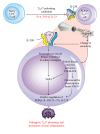A Potential Link between Environmental Triggers and Autoimmunity
- PMID: 24688790
- PMCID: PMC3945069
- DOI: 10.1155/2014/437231
A Potential Link between Environmental Triggers and Autoimmunity
Abstract
Autoimmune diseases have registered an alarming rise worldwide in recent years. Accumulated evidence indicates that the immune system's ability to distinguish self from nonself is negatively impacted by genetic factors and environmental triggers. Genetics is certainly a factor, but since it normally takes a very long time for the human genetic pattern to change enough to register on a worldwide scale, increasingly the attention of studies has been focused on the environmental factors of a rapidly changing and evolving civilization. New technology, new industries, new inventions, new chemicals and drugs, and new foods and diets are constantly and rapidly being introduced in this fast-paced ever-changing world. Toxicants, infections, epitope spreading, dysfunctions of immune homeostasis, and dietary components can all have an impact on the body's delicate immune recognition system. Although the precise etiology and pathogenesis of many autoimmune diseases are still unknown, it would appear from the collated studies that there are common mechanisms in the immunopathogenesis of multiple autoimmune reactivities. Of particular interest is the citrullination of host proteins and their conversion to autoantigens by the aforementioned environmental triggers. The identification of these specific triggers of autoimmune reactivity is essential then for the development of new therapies for autoimmune diseases.
Figures















References
-
- Selmi C, Lu Q, Humble MC. Heritability versus the role of environment in autoimmunity. Journal of Autoimmunity. 2012;39(4):249–252. - PubMed
-
- Bogdanos DP, Smyk DS, Rigopoulou EI, et al. Twin studies in autoimmune disease: genetics, gender and environment. Journal of Autoimmunity. 2012;38(2-3):J156–J169. - PubMed
-
- Mahdi H, Fisher BA, Källberg H, et al. Specific interaction between genotype, smoking and autoimmunity to citrullinated α-enolase in the etiology of rheumatoid arthritis. Nature Genetics. 2009;41(12):1319–1324. - PubMed
Publication types
LinkOut - more resources
Full Text Sources
Other Literature Sources

